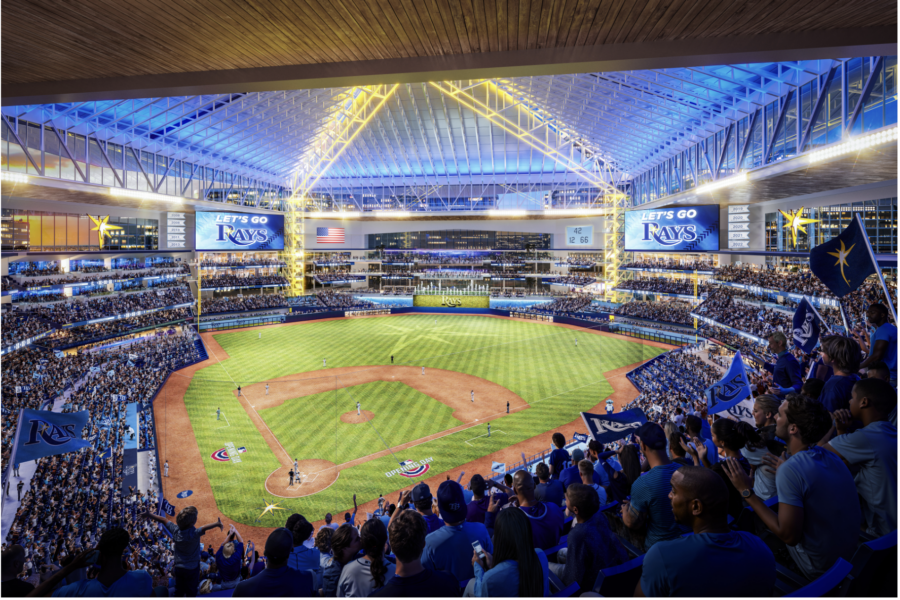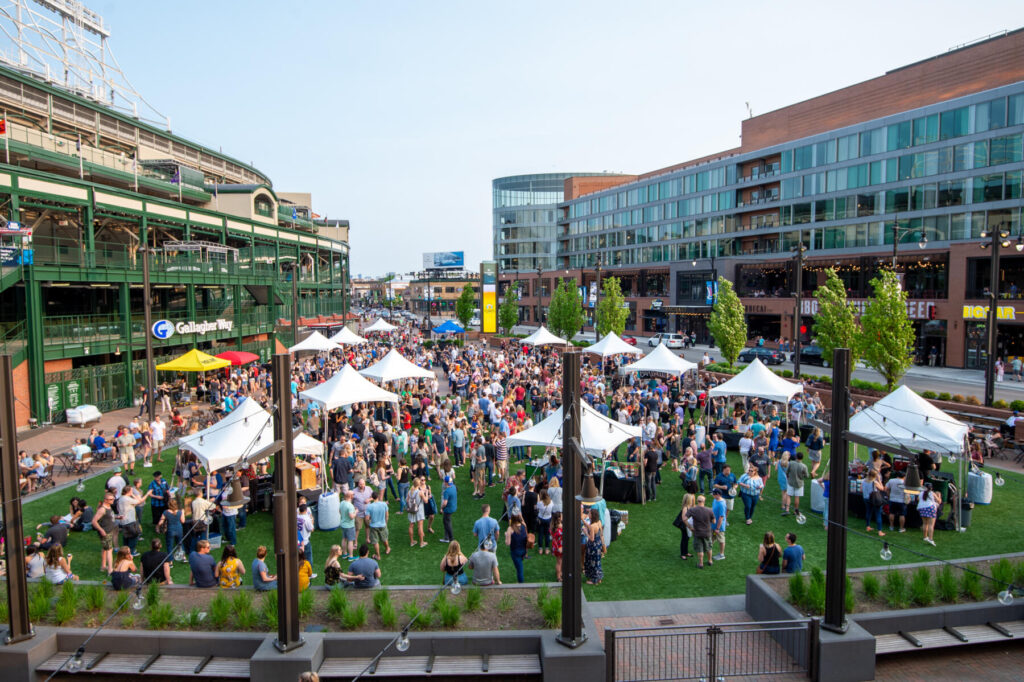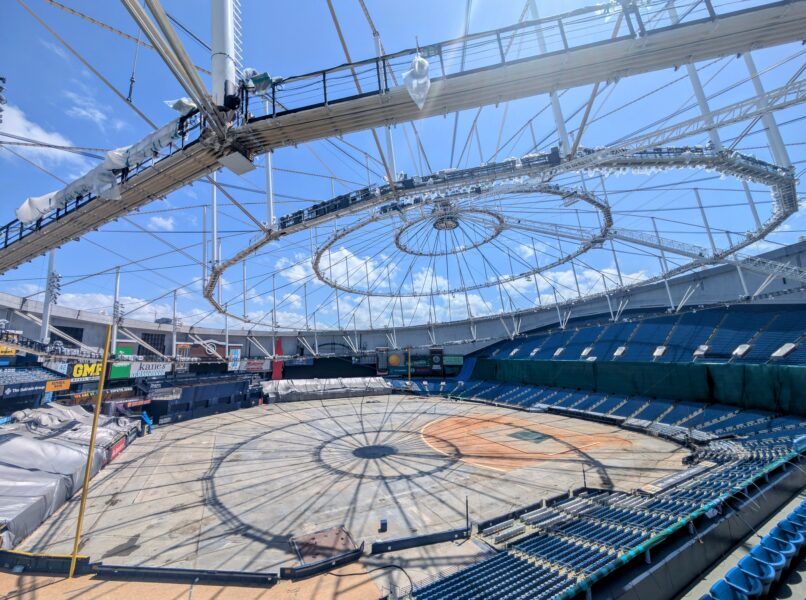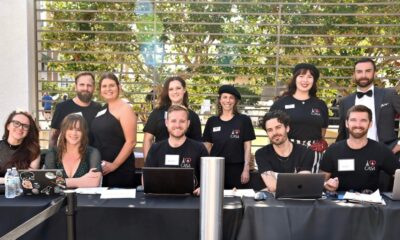Thrive
Inside the vision for a new Rays ballpark

While a new Tampa Bay Rays ballpark will look decidedly different from Tropicana Field, the new digs will feature one reimagined mainstay – a stingray touch tank accessible year-round.
Zach Allee, principal and senior architect at Populous, said the overarching goal is creating a place “where people love to be together.” An evaluation committee comprised of St. Petersburg and team officials selected the global firm to complete the $1.3 billion stadium’s architectural and engineering services.
While it is still early days – new renderings are months away – Allee said the design process is well underway. He stressed the uniqueness and benefits of simultaneously planning a ballpark and its surrounding community.
“Not only are those elements really exciting and somewhat different, the site is in the heart of the city,” Allee said. “It’s like you get the best of all worlds. We feel like it’s the next generation in the evolution of ballparks.”

Zach Allee, principal and senior architect at Populous.
Like Populous, Allee calls Kansas City, Missouri, home. However, he and the firm have worked with the Rays since 2007. The University of South Florida also selected the company to design its long-awaited on-campus football stadium.
Allee said he worked on the Rays’ spring training complex in Port Charlotte and helped design concepts for a once-proposed ballpark at the Al Lang Stadium site. “I’ve grown up with the Rays throughout my career in St. Petersburg and have come to love this place a long time ago,” he said.
Integration
Populous designed Camden Yards, home to the Baltimore Orioles. Allee noted it represented a shift back to incorporating ballparks into a city, like early 20th-century stalwarts Wrigley Field and Fenway Park.
The firm also helped create Truist Park, home to the Atlanta Braves. While in the suburbs, the development team designed a community around the new stadium.
“You (St. Petersburg) can have bars and restaurants that plug right into the ballpark,” Allee said. “You have an opportunity to integrate a new development on a historic site … that we want to honor and reflect. We hope that we just enhance all of the wonderful surroundings that already exist in St. Pete.”
He compared the Historic Gas Plant District’s $6.5 billion redevelopment to designing Wrigleyville – the vibrant, mixed-use neighborhood surrounding Wrigley Field – when the stadium opened in 1914. Fostering accessibility is a prominent theme.
Populous plans for the ballpark to integrate seamlessly into the redevelopment and city. Allee hopes to make discerning where the stadium begins and the community ends challenging for visitors.

Wrigleyville on game days. Photo: Choose Chicago.
Experiences
Allee said providing indoor-outdoor spaces that increase accessibility is a focus. Glass “view corridors” along the ballpark’s upper edges are a prominent feature.
In addition, “operable walls” will open to the street and increase community integration. Allee said Populous is studying sightlines, efforts bolstered by a holistic redevelopment project.
He said the firm is “thoughtfully” coordinating views from the ballpark into the surrounding area. Populous is also considering a mechanism to eliminate barriers between concourse vendors and people outside the stadium.
The firm has designed myriad arenas and concert venues. Allee said Populous would apply that expertise, including acoustics, to a new ballpark that will host year-round events.
Ensuring playability is a priority, and Allee noted the Trop’s design interferes with baseball flight patterns. Populous will utilize Major League Baseball’s tracking data to keep the lowest possible stadium profile.

An aerial rendering of the Historic Gas Plant District’s redevelopment. Image provided.
Allee said the roof’s downward slope would maintain the Edge District’s scale. “We want this to be a neighborhood ballpark,” he stressed. “That isn’t just a spaceship plopped onto the site.”
Allee said the stadium’s reduced capacity – 30,000 on game days – will benefit fans. He plans to foster intimacy by putting “as many of the seats as close to the action as possible.”
The ballpark will feature several viewing options throughout various “neighborhoods” and plenty of social seating. “All of those things will be incorporated in ways that will be uniquely St. Pete,” Allee said.
“We’ll continue to study different aspects of the community and make sure that all of those are reflected somewhere in the ballpark and various fan experiences.”
Responsibility
Allee said Populous is working closely with local architect Everald Colas, founder of Story Studio, to integrate the Gas Plant’s rich African American history into the ballpark. Allee called that a “core value.”
The company’s “huge responsibility” includes meeting taxpayers’ expectations. “I think this significant community building in St. Petersburg, and we love St. Petersburg,” Allee added.
He pledged that Populous, through local partnerships, will ensure the project aligns with the city’s people and culture. Allee believes that focus differentiates the firm from other international companies.
“If its (the ballpark) a reflection of St. Pete, and St. Pete loves it, it’s going to be great,” he said.

Populous plans to seamlessly integrate the ballpark into the surrounding community.







Matt Bruner
June 2, 2024at6:21 am
You all are horrible not supporting your team. I have a team in the Reds who have a horrible owner, manager is horrible and the ball park is a waste. I get that this stadium funded not the greatest way but again your team at least has a winning team.
Mel Mitchell
March 31, 2024at4:59 pm
What a waste of taxpayer money…. Add to that all the “affordable housing” crap being played into it and it’s a lose lose proposition. Tax breaks are okay just like any other business, but NO taxpayer money should go into it. As far as affordable housing, run the housing union guy out of town and quit electing idiots that buy into this crap. The market will adjust itself, if allowed.
HAL FREEDMAN
March 11, 2024at11:38 pm
These hashtags say it all: #rayspaynorent #rayspaynotaxes #rayspaynorevenue and #demandmore! This is an awful deal for St. Petersburg taxpayers! 30,000 seats? After the new toy shine wears off, attendance will be 1/2 that at best.
Kill the deal, let the Rays leave, wait until 2027 to develop the property…then the Rays get no proceeds from development. It will be a major windfall for the City and us taxpayers! We don’t need an MLB team. They have not been a major factor in the city’s growth over the past 20 years.
Jim W.
March 11, 2024at4:13 pm
All the new ballpark renderings I’ve seen thus far show no parking close to the stadium. If this is the case, then where is the actual parking and would fans then need to use some kind of shuttle to get to the stadium ??
S. Rose Smith-Hayes
March 11, 2024at12:55 pm
The plans show that the new stadium will be smaller. Why can’t you just gut the existing stadium for a remodel instead of tearing it down. It is a total waste to trash that existing building.
Conrad
March 10, 2024at4:02 pm
The Rays should move to a city that is willing to support baseball. I see the rays in the same situation as the Coyotes of the NHL.
Robert Dimaio
March 10, 2024at3:10 am
When is the new stadium opening?
J Dropp
March 9, 2024at7:05 pm
Truly want a Stadium
. Season ticket Parking lot a must. Otherwise will give up my 1998 Season Tickets
Andy
March 9, 2024at5:10 pm
The big elephant hiding here is where do you park all the cars? Currently for 90% of the year the Trop is just an unused ballpark in the middle of a huge swathes of blacktop….ugly and a desert in a City. I do not see anything on the plan or images showing surface of multi-story parking.
Ryan Todd
March 9, 2024at4:58 pm
The Rays must be the largest single contributor to the Catalyst. Why do you keep running these fluff pieces that read like a commercial instead of producing actual journalism?
mark Ferguson
March 9, 2024at4:29 pm
This is great for the city of saint Pete also will the new stadium be available for conventions?
James Mack
March 9, 2024at4:21 pm
This is SO exciting! We love the Rays, and can’t wait to see them play in their new home!
Alan DeLisle
March 9, 2024at12:10 pm
The “sales” job continues. The Catalyst should focus on one thing: what will be in the Development Agreement. Will it be as bad as the Term Sheet? Why is the city paying for all site infrastructure improvements? Will the Rays/Hines pay market value for the land used for development, and if not, why not? What are the exact development requirements and when do they have to occur? Why is the city paying for the community benefits, green space on site and the affordable housing? Why is this the worst stadium/ development deal ever done? Catalyst should be more concerned about what the city will look like, not the stadium. Stop the Music Man.